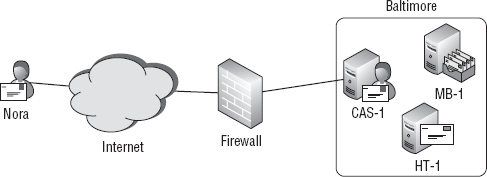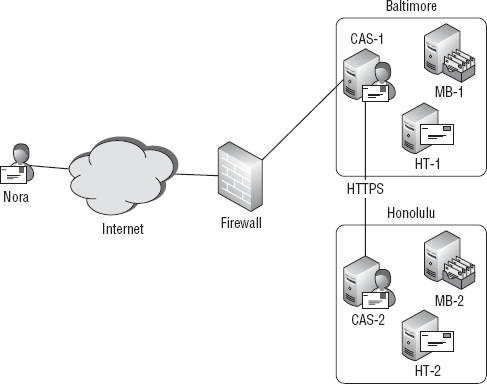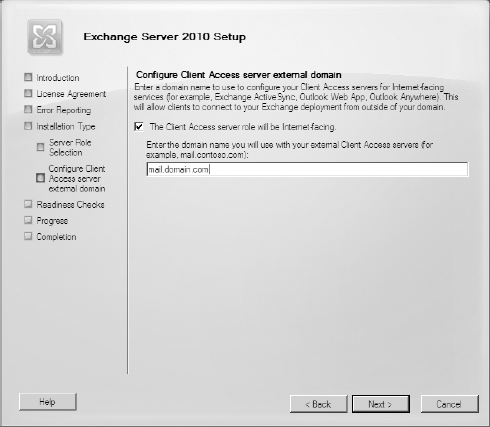After you complete your design for the
hardware on which the Client Access server role will run, the next step
to consider is the positioning of the Client Access server role in your
LAN. As a bare minimum, every Active Directory site hosting a Mailbox
server also requires a CAS.
As with Exchange Server 2007, you want to avoid
placing your Exchange Server 2010 Client Access servers in your
perimeter network. This is important because the CAS uses RPCs to
connect to the Mailbox server role. Because of this, the number of
ports you must open to provide access for your CAS leaves a rather
large hole for potential attack. You can either publish a CAS directly
to Internet clients or you can use a reverse proxy to provide an
additional layer of protection. We strongly urge you to put your Client
Access servers on your internal network and use a reverse proxy to
publish the servers to the Internet.
So what are you expected to do? Our recommendation
is to place the Client Access server role on your internal LAN and then
proxy connections to it using a reverse proxy server like ISA Server
2006 or Microsoft's successor, Forefront Threat Management Gateway
(TMG). This gives you many benefits, not the least of which is that the
only thing being exposed directly to Internet traffic is the
proxy/firewall—which is designed specifically for that exposure. When
using ISA or TMG, you also get the benefit of preauthentication, which
ensures that only authenticated traffic gets through to your internal
LAN. On top of this, all inbound connection requests are inspected to
ensure they are valid. This makes things even more secure by closely
checking all traffic to your Client Access servers for potential HTML
exploits and nonstandard HTML requests before passing it through to
your LAN.
1. Client Access Server Proxying
Let's take a more detailed look at how remote access
works and, more specifically, how your placement of Client Access
servers and Internet connections affects what happens.
First, you need to understand how Client Access
servers talk to Mailbox servers when users try to access their
mailboxes. If you have a single Active Directory site (Baltimore) with
Exchange servers in it, then you have a fairly simple scenario, as
shown in Figure 1.
You would provide remote access via a reverse proxy or some other type
of firewall. In this scenario, the user talks to the CAS (either
directly or through the firewall) and the CAS talks to the Mailbox
server.

So what about when you introduce another Active
Directory site (Honolulu) with Mailbox and Client Access servers? It
depends. Let's look at a situation where a user, Nora, has her mailbox
on a Mailbox server in Honolulu. If Nora were to use Outlook Web App to
access the CAS in Baltimore (CAS-1), the server would look up Nora's
mailbox location in Active Directory and find that her mailbox is
actually hosted on a Mailbox server in Honolulu (MB-2).
At this point, the CAS in Baltimore (CAS-1) will
determine if an external URL is configured for the CAS in Honolulu
(CAS-2). If not, CAS-1 will contact CAS-2 and then proxy Nora's request
to it. CAS-2 gets the info from Nora's Mailbox server and passes it
back to CAS-1. From there the information is returned to Nora. So
proxying is nothing more than one CAS telling another CAS to access the
user's mailbox because it can't contact the Mailbox server itself. As
shown in Figure 2,
the cross-site traffic between Client Access servers uses HTTPS, and
not RPC. HTTPS is better to use than RPC for long-distance connections
that are unreliable and susceptible to network latency.

When designing your Exchange topology to include
Client Access servers, keep in mind that proxying only works in a
point-to-point fashion between the requesting CAS and a CAS in the same
site as the Mailbox server. If firewalls are in place that prevents
this traffic, the CAS will not negotiate a hop-to-hop route via another
site where there is connectivity.
In previous versions of Exchange, there were a
couple of cases where proxying could not be used: when connecting via
IMAP or POP3. However, Exchange 2010 now provides support for IMAP and
POP3 proxying. Client Access servers are configured for proxying IMAP
and POP3 by default. Proxying only works for virtual directories
configured for Integrated Windows authentication, which means if you
want Forms-based authentication (FBA) or Basic Authentication to be
used internally, you will need to configure a separate Outlook Web App
virtual directory for use when inside your network.
To provide a better understanding of proxying, we want to introduce you to two important parameters. The InternalURL and ExternalURL
parameters can be specified on web-accessible virtual directories, such
as Outlook Web App, the Exchange Control Panel, Exchange ActiveSync,
and the Offline Address Book distribution web service. These parameters
define how the CAS performs proxying and redirection. In many cases,
Client Access servers that are Internet facing should have their
public, Internet-accessible URL in the ExternalURL parameter
for the web services that are accessible over the Internet, such as
Outlook Web App or Exchange ActiveSync. For example, this URL could be https://webmail.domain.com/owa. If you don't specify an ExternalURL
for your Internet-facing servers, those servers won't be used for
client redirection. If you are using a single-site configuration, you
don't need the ExternalURL specified for OWA. However, if you
want to take advantage of using Autodiscover for external client
configuration, you will still need to configure ExternalURL for Exchange ActiveSync, Offline Address Book distribution, and Exchange Web Services.
In the InternalURL parameter, the CAS
should have the URL that users inside the network will use to access
it. This is important, because when a Client Access server (CAS-1)
realizes that the mailbox it's looking for isn't in its site, it looks
in Active Directory to find another Client Access server (CAS-2) that
is in the same site as the mailbox that it wants to access. When CAS-1
uses CAS-2 as a proxy, CAS-1 uses the InternalURL parameter for CAS-2 to figure out how to connect to it. If your InternalURL is wrong or missing, that server can't be used for proxying.
Back in Exchange Server 2007, only the InternalURL was specified during installation. If your organization had Internet-facing Client Access servers, you had to configure the ExternalURL
parameters on the virtual directories after Exchange was installed.
However, there is a new screen added to the Exchange Setup process in
Exchange Server 2010 that allows you to configure your external URL
when the CAS is installed and the appropriate virtual directories are
configured for you. This screen is shown in Figure 3.

The InternalURL is the server's fully qualified domain name (FQDN), which is also what the default self-signed certificate uses for its subject name. This could
potentially be the name that the clients inside your network will use
to access the service on your CAS. If you are configuring a CAS only
for internal access (either for use by internal clients or for other
Client Access servers that proxy requests to it), you should set the ExternalURL parameter to $Null for the virtual directories listed here:
Outlook Web App
Exchange Control Panel
Offline Address Book
Exchange ActiveSync
Exchange Web Services
PowerShell
Table 1 summarizes the recommended InternalURL and ExternalURL
configurations. There are some important things that you should note
about this information. First, a split-brain DNS architecture is
assumed. This means that the namespace used on your internal DNS
servers is also the namespace used on your external DNS servers.
Technically both zones are authoritative, but the server used will
depend on whether the client is coming from inside or outside your
network. Second, this information assumes that you are using
load-balanced Client Access servers, which we recommend as a standard
practice in Exchange 2010. And finally, you should configure the AutoDiscoverServiceInternalUri property to be the FQDN of the load balancer on the CAS and the EWS property called InternalNLBBypassURL should be set to the Client Access server FQDN.
Table 1. Recommended InternalURL and ExternalURL Configurations
| Virtual Directory | InternalURL | ExternalURL (Internet-Facing Servers) | ExternalURL (Non-Internet-Facing Servers) |
|---|
| OWA | CAS Server FQDN | Load-Balancer FQDN | $null |
| EWS | Load-Balancer FQDN | Load-Balancer FQDN | $null |
| ActiveSync | Load-Balancer FQDN | Load-Balancer FQDN | $null |
| Offline Address Book | Load-Balancer FQDN | Load-Balancer FQDN | $null |
| Unified Messaging | Load-Balancer FQDN | Load-Balancer FQDN | $null |
| ECP | Load-Balancer FQDN | Load-Balancer FQDN | $null |
If you don't specify an external URL for your Client Access servers during Exchange setup, the ExternalURL
parameter will already be empty. You only need to go back and clear the
parameter if you've specified an external URL for your CAS but don't
want every web service available externally. For example, you could
disable the ExternalURL parameter for the Outlook Web App service, but keep it enabled for the OAB distribution service. You can only clear the ExternalURL
parameter on some of the virtual directories using the Exchange
Management Console (EMC). For the rest, you will need to use the
Exchange Management Shell (EMS). Table 2 lists each EMS cmdlet that you can use to clear the ExternalURL parameter.
Table 2. EMS Cmdlets for Setting the ExternalURL Parameters on Different Virtual Directories
| Virtual Directory | EMS Cmdlet |
|---|
| Outlook Web App | Set-OwaVirtualDirectory |
| Exchange Control Panel | Set-EcpVirtualDirectory |
| Offline Address Book | Set-OabVirtualDirectory |
| Exchange ActiveSync | Set-ActiveSyncVirtualDirectory |
| Exchange Web Services | Set-WebServicesVirtualDirectory |
| PowerShell | Set-PowerShellVirtualDirectory |
The following example demonstrates the usage of the Set-OwaVirtualDirectory cmdlet in the EMS to set the default OWA virtual directory ExternalURL parameter to a null value:
Set-OwaVirtualDirectory "CAS-1\owa (Default Web Site)" -ExternalURL $Null
|
Outlook Web App and the Exchange Control Panel are
closely tied together. Users will be logging into OWA to read their
mail and then use the ECP to access their options. If you set an ExternalURL for OWA, but not for ECP, users may not be able to use the Options button in OWA. When setting the ExternalURL parameter on the OWA virtual directory, make sure that you set the ExternalURL parameter on the ECP virtual directory as well.
|
To demonstrate how the InternalURL and ExternalURL
affect proxying, let's take another look at what happens when Nora
tries to get to her mail from that Baltimore CAS. Here's what happens
when Nora tries to open Outlook Web App:
The CAS in Baltimore (CAS-1) locates a CAS in the same Active Directory site as Nora's Mailbox server (Honolulu).
The Baltimore CAS determines if the Honolulu CAS has the ExternalURL
property configured. If it does, Nora's web session is manually
redirected to the Honolulu CAS .
If the Honolulu CAS does not have the ExternalURL set, then the Baltimore CAS checks for an InternalURL on the Honolulu CAS.
If the InternalURL
is configured and the web service is configured to use Integrated
Windows authentication, the connection is proxied to the location
specified in the InternalURL property.